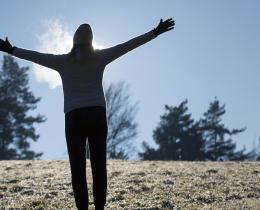Awaken-to-Spring Sequence
From Gina Norman, owner of Kaia Yoga in Connecticut, where she leads the Kaia Yoga teacher training.
Just as the darkness of winter changes to the rebirth of spring, so do we. Staying connected to your body and breath during this time will help you harness the inner wisdom and insight that solitude brings. With this clarity, you too can spring into action by bringing your insight to fruition. Honoring this transition in your yoga practice can help to ease you into this revitalizing season.
A few ways to modify your practice for spring include adding detoxifying twists, invigorating core work to wake your digestive system and strengthen your body as you move into this more active season, and hip openers and backbends to open your energy outward as you move from an internal to a more determined and engaging focus of the rebirth of spring.
Here are a few yoga poses that aid in detoxification and invigorate all the systems of the body, renewing you for the energy of this season. Use this 6-pose sequence to wring out your body, awaken your core and open your hips this spring.
1) Child’s pose (Balasana)
Lower down to hands and knees and press your seat back toward your heels with the big toes touching and the knees separated wider than the torso. Place the forehead on the floor or your torso on a bolster or blanket for support. Arms can relax down by your side or out in front of you. Close the eyes and breathe into the upper back between your shoulder blades.
What intentions come to mind for you as you look toward spring? What are three new things that you may want to explore this season?
Take 10-15 breaths in this pose expanding out into your body as you inhale and finding ground and comfort inward as you exhale.
2) Low Lunge (Anjaneyasana)
From child’s pose, come onto your hands and knees. If your knees need a stretch, you may want to take a downward facing dog and peddle out the legs to release them before coming into lunge. Step the right foot forward and lower the left knee down to the mat. Lift your spine up into a backbend, either keeping your hands on your front knee or lifting your arms overhead in line with your ears.
Take 8-10 deep breaths here with each inhale lifting from your base and core and extending the spine up as your lift your chest and arch your back. If it is comfortable for you to look up, make sure to keep length in the back of the neck.
This pose will wake up the hips and start to move your energy up the spine, building the heat needed to wake up your digestion and move fresh prana through your channels (nadis).
3) Boat Pose (Paripurna Navasana)
Sit on your mat with your legs out in front of you, bend your knees in toward your chest using your hands as support behind your knees. As you lift your feet off the mat, lift your lower back to engage your core and lengthen your spine tall from tailbone to crown of the head. Moving deeper into this pose you can play by reaching your arms forward and starting to straighten the legs for more work in the core.
Hold for 8-10 breaths.
Notice as it becomes more challenging or if your breath shortens and work to come back to an even breath in and out. This pose is great for waking up the digestive system and giving you courage as you move yourself outward toward spring.
4) Dhanurasana (Bow Pose)
Lay face down on your mat. Bend your knees and grasp your ankles with your hands. If that reach is uncomfortable, you may bring your hands behind your back and intertwine fingers making a fist then lift legs and chest away from the ground. Expand the breath into the upper chest as you lift the front body and legs up. Don’t throw the head back, but instead let the backbend build from extending the spine and opening across the chest. Use your inhale to lift the chest, legs, and toes toward the ceiling and the exhale to notice places in the front of hips and upper back that you can soften to release, allowing you to open.
Take 5–8 deep breaths and repeat 3 times.
Press back to wide knee Child’s Pose and take 3-5 breaths.
This pose is wonderful for building energy in body and mind and it massages your internal organs, aiding in detoxification.
5) Marichyasana III (Pose Dedicated to the Sage Marichi)
Begin in staff pose (Dandasana) with your legs out in front of you as you lift your lower back to engage your core for support. Your weight should be on top of your sit bones. Bend the right knee and place the sole of the foot flat to the floor, aligning the heel with the right sitting bone. Bring your foot as close to your seat as you can comfortably. Lift your arms up overhead as you twist to the right. Place the right hand on the floor a few inches behind the tailbone as you anchor your left elbow to the outside of your right knee. Gazing back over your right shoulder, keep your chin parallel to the floor as you twist. With each breath, draw your belly toward the spine to deepen your twist on the exhale.
Hold for 8–10 breaths. Repeat on the left side.
This pose calms the nervous system while lubricating the spine and massaging and cleansing internal organs.
6) Paschimottanasana (Seated Forward Fold)
Start seated with legs straight out in front of you in staff pose (Dandasana). Inhale your arms overhead, and on your exhale extend and fold your torso over your legs. If your weight is rolling back and your lower back is rounding sit up on a block or blanket to bring your weight forward onto your sit bones. If it feels tight in the back of the legs, you may need to bend your knees up away from the mat to lift and extend your spine. Lay your belly first, then your ribcage on your thighs and then let your chest and head release toward your legs. Keep the legs active, the feet flexed as you breathe, and fold over your legs.
Hold for 8–10 breaths.
This pose will open the outer body and hamstrings and invigorate the legs and belly.
This entire sequence can be repeated a few times a week or practice the poses separately anytime you feel sluggish and want to renew your energy.




